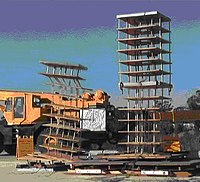
Photo from wikipedia
Abstract The multi-hazard effects on multi-story steel buildings equipped with energy dissipative passive vibration response control devices are investigated for their performance under earthquake- and wind-induced forces. The passive response… Click to show full abstract
Abstract The multi-hazard effects on multi-story steel buildings equipped with energy dissipative passive vibration response control devices are investigated for their performance under earthquake- and wind-induced forces. The passive response control devices include steel bracings, viscous, and viscoelastic dampers. The buildings without and with the passive control devices are modeled as multi-degree of freedom (M-DOF) systems, with the seismic masses lumped at each floor level. The governing differential equations of motion for the uncontrolled and controlled buildings are solved by using Newmark’s time integration approach. The dynamic response quantities are compared in terms of statistical distribution, which include the statistics of top floor acceleration, inter-storey drift, column base shear, and top floor displacement, for the uncontrolled and controlled buildings subjected to earthquake- and wind-induced forces. Conditional probabilities of failure are determined by overlapping the probability density function curves and conducting fragility analysis through cumulative distribution function curves to assess the effectiveness of the control devices against the natural hazards. It is observed that the design of the passive control devices employing additional damping may account for the performance of the structures under the multi-hazard scenario. Moreover, the variability in either of the demands affects the failure probability of the passively controlled structures extensively. Therefore, the probability of failure for a structure experiencing high-amplitude seismic hazard and a maximum wind speed within the critical frequency band during the design life varies largely for different damper schemes, which calls upon careful selection for design of a structure considering such multi-hazard scenario.
Journal Title: Structural Safety
Year Published: 2020
Link to full text (if available)
Share on Social Media: Sign Up to like & get
recommendations!